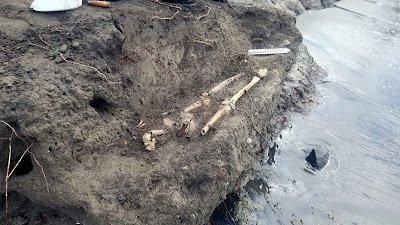As we wind down the end of 2022, a long-awaited report on Sauteurs Bay is finally ready. Hanna first started this manuscript back in 2018, but there was just more and more to add. There is more still, of course -- we hope to have osteological analysis completed on the site's human burials in 2023, as well as aDNA analysis and more excavations. But there's always more to do. It's been four years and 150 pages now, so time to just get it out there!
And one of the core issues addressed is quite urgent. The site (and the communities along Sauteurs Bay) have been suffering from extreme erosion every dry season for the past five years. Homes and businesses have been destroyed as well as one of Grenada's most important archaeological sites, as seen through a continuous stream of human skeletons ripped by the waves into the sea. The archaeological site dates as early as AD 300, but the burials falling into the sea mostly date between AD 900-1200. And of course, this is the village that was razed by French forces in 1650, during the eponymous massacre at le Morne des Sauteurs (Leapers’ Hill).
Unfortunately, the high-breaking waves are not merely climate change -- they are the result of an ill-conceived and poorly-planned government breakwater project that finished in early 2017. At first, the breakwater was hailed as a great success (even toured by the PM), and the town of Sauteurs itself was indeed saved from ongoing erosion. But there was no Environmental Impact Assessment done, nor were previous studies (like the RRACC) consulted. Had more thought been put into this thing, they would have known that the currents changed between the rainy and dry seasons -- and thus, come the next dry season, the swells would be concentrated and redirected towards Mt. Craven, a small beach community just west of town, causing catastrophic damage. But they didn't. And then they ignored it and sat on their hands whilst the destruction continued unabated.
The first part of this new report provides some documentation for the recent catastrophe and references the studies done. The second part synthesizes all past research on the archaeological site itself, including preliminary results from a community archaeology project (SCHAP) in early 2022. In the process, the report offers a case-study in the (mis-)management of Grenada’s rich heritage – with recommendations and lessons learned for the future.
This publication also marks the first in a new "Occasional Research Papers" series by the GNM Press. We hope that that future academic reports about Grenada can be published through the Museum in this way, on various topics related to the natural and cultural history of Grenada.
A pdf of the report is freely available on ResearchGate here: https://www.researchgate.net/publication/365769739_Archaeological_Background_of_Sauteurs_Bay_Grenada_Site_GREN-P-5_Settlement_Burial_and_Disaster_in_the_Shadow_of_Leapers%27_Hill
A color hardcopy can also be printed at-cost ($11 USD) via the GNM Press account on most Amazon country websites (Amazon.com, Amazon.ca, Amazon.co.uk, Amazon.de), e.g., https://www.amazon.com/dp/B0BR9DKXKL

Comments
Post a Comment
Thanks for your feedback! Please note that if the blog post is older than 14 days, it may take some time for us to respond (most comments tend to spam at that point). Cheers, -JAH and JAM